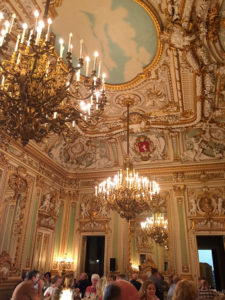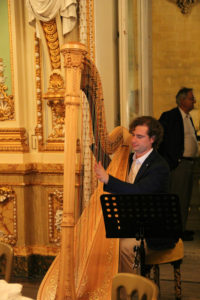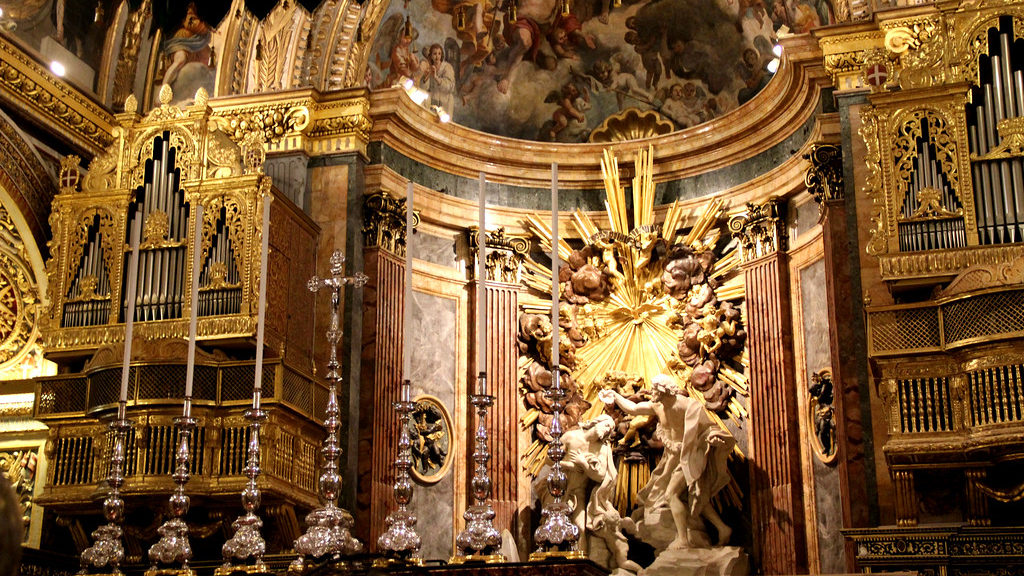
Malta – Mdina and Valletta
When I booked our Rome, Amalfi Coast, Sicily and Malta tour, I thought of Malta as a nice add-on, but wasn’t expecting anything much. Malta ended up to be a nice surprise. For such a small country, it has quite a history, some of which I will share here. Farmers initially settled Malta, as early as 5000 BC. Over the years, Malta has been controlled by many different leaders, some (but not all) of which, include Phoenicians, Carthaginians, Romans, Arabs, Normans, and the British. All of these entities wanted to control Malta because of its important strategic position in the Mediterranean both militarily and economically. The British took control of Malta in 1814 under the Treaty of Paris. They established an important naval base in the Grand Harbor near Valletta. It was also an important harbor for merchant shipping.
The strategic importance of Malta was very apparent during World War II. Italy joined the Axis Powers so there was some question as to whether Malta could be defended because of how close it was to Italy. But the British believed it was critical to their Mediterranean fleet. Malta was heavily bombed during the war with perhaps over one million bombs hitting the country. King George VI awarded the entire nation of Malta with the George Cross, stating:
To honor her brave people, I award the George Cross to the Island Fortress of Malta to bear witness to a heroism and devotion that will long be famous in history.
A representation of the George Cross is incorporated into Malta’s flag. Malta became an independent nation in 1964, although Queen Elizabeth II remained head of state. In 1974 Malta became a republic with a president appointed by the Parliament. Malta became a part of the European Union in 2004.
Pictured below is the harbor near Valletta and the Maltese Cross. The Maltese Cross came to Malta by way of the Knights of St. John of Jerusalem in 1530. Its history even predates its introduction to Malta. It was a cross used by the knights during the Crusades. The cross has eight points which represented the obligations of knights: “to live in truth, have faith, repent one’s sins, give proof of humility, love justice, be merciful, be sincere and wholehearted, and to endure persecution.” Today it is a common symbol in Malta – we found jewelry and other items featuring the cross in many shops.



We drove to Mdina, once the capital of Malta. It is a walled city dating back to medieval times. It is on top of a plateau which made it easy to defend. There was an earthquake in 1693 resulting in much damage. Much of the city was rebuilt in the early 18th Century. We entered Mdina through the Main Gate, one of three gates into the city (first and second pictures). The gate and most of the fortification walls were rebuilt – the gate in 1724. The coat of arms of the Grand Master Manoel de Vilhena was carved into the gate (third picture). The fortification walls on either side of the gate can be seen in the next picture. There was a moat that offered further protection, although it was never filled with water. After walking through the gate into Mdina, our guide had us look back at it from the inside. We saw that it was decorated with carvings of Mdina’s three patron saints, St. Publius, St. Paul and St. Agatha (last picture).

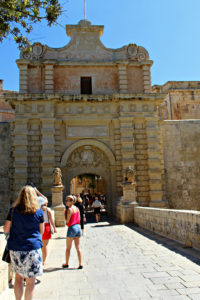
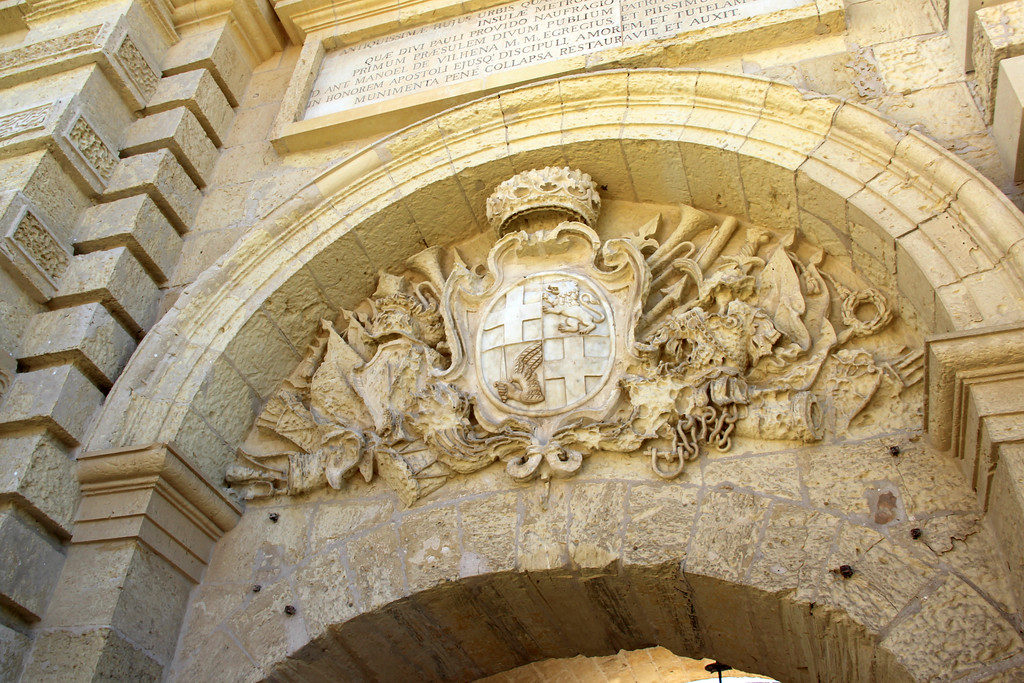
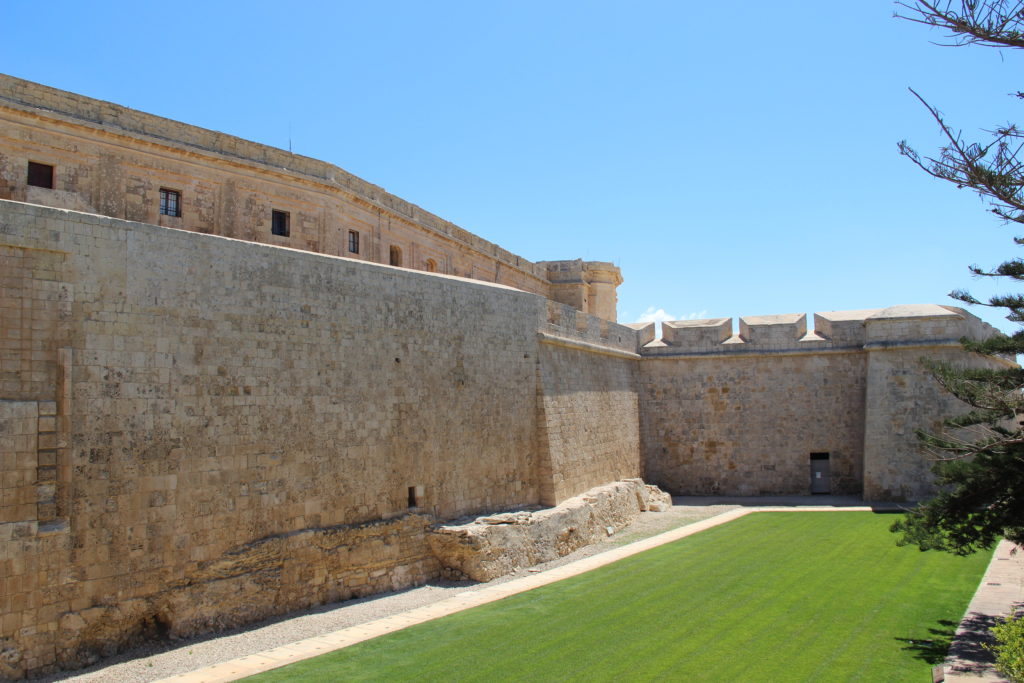
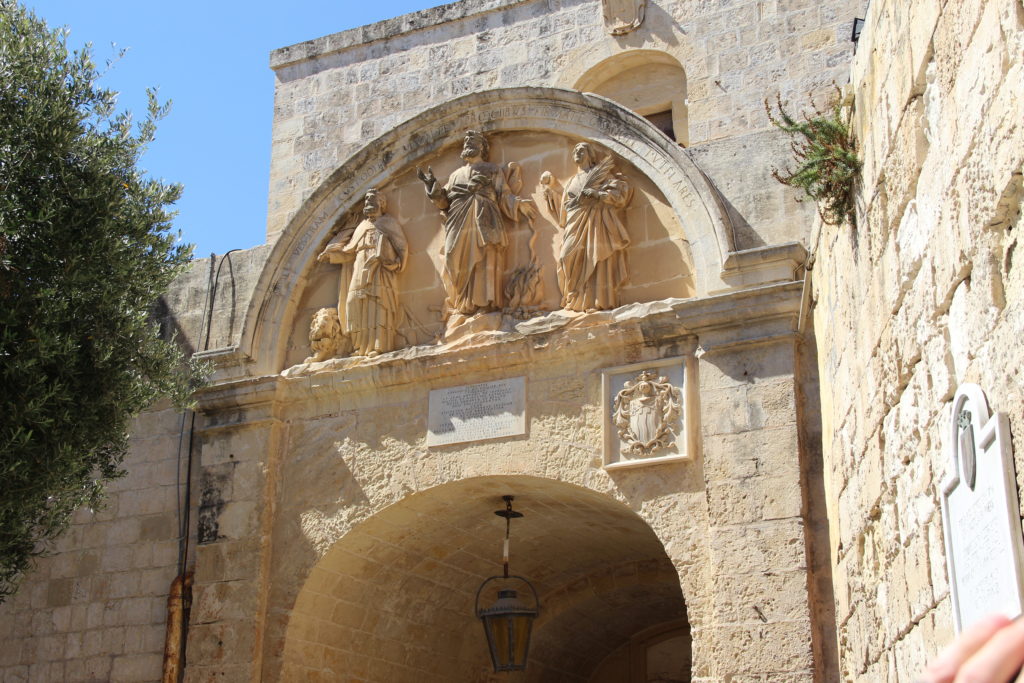
When we entered Mdina through the Main Gate, we were in St. Publius Square. One of the buildings there was the Vilhena Palace (first picture) which now serves as the National Museum of Natural History. Like the Main Gate, the palace was built at the direction of Grand Master Manoel de Vilhena, whose coat of arms is also at the entrance to the palace. There is a beautiful courtyard – the picture of the Maltese Cross which I included earlier in this post was taken in the courtyard.
The next picture is the Mdina Cathedral, also known as St. Paul’s Cathedral. It is on St. Paul’s Square, the central square in Mdina. The Cathedral was completed in 1702 on the site of St. Publius’s home. He is buried under the altar. St. Paul was shipwrecked on the island of Malta and healed St. Publius’ father. St. Publius then converted to Christianity and was the first bishop of Malta. The Cathedral has two bell towers, each with a clock. One tells the time and the other the date. We did not go inside the church, but I have read it is another beautiful cathedral.
The third picture is of the Annunciation Church also known as the Carmelite Priory Church. The building was completed in 1675. On the outside of the church is a statue of Mary with Jesus. During the French occupation of Malta, the French stole silver from the church and they were returning to steal valuable wall hangings. The church was locked and the church bells were rung in alarm. Many came to defend the church, which began the revolution against the French. A picture of the bell tower is also included.
While we saw many prominent historical buildings, we also saw a small shop with its own story and history (fifth picture). The shop is operated by a father and son, and the father’s father before him. They are gilders and restore treasures, many of which are church relics, a long and detailed process with the restoration sometimes taking a year. I found an interesting article on their work, a brief portion of which follows (https://www.thetraveltrunk.net/gilders-golden-touch-in-mdina-malta/).
Small areas are worked on as other areas slowly come into play as they switch from gesso work to painting or gilding another small part…The burnishing tools used to bring the applied fine gold leaf to its full life are themselves over 100 years old and were used by Kevin’s grandfather at the end of the 19th century in that very same compact workshop.
The last picture is a sign which refers to Mdina as the “silent city.” I have found a couple of reasons for this reference. One is that Mdina is surrounded by a wall so is relatively unseen. The other is that it was once a very important city, but when the capital was moved from Mdina to Valletta, its importance diminished and it never returned to its previous status.


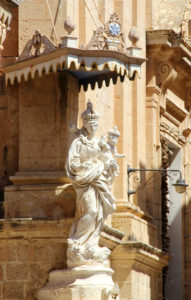
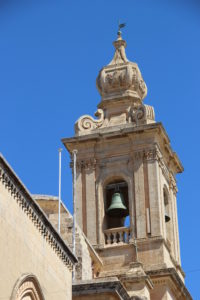

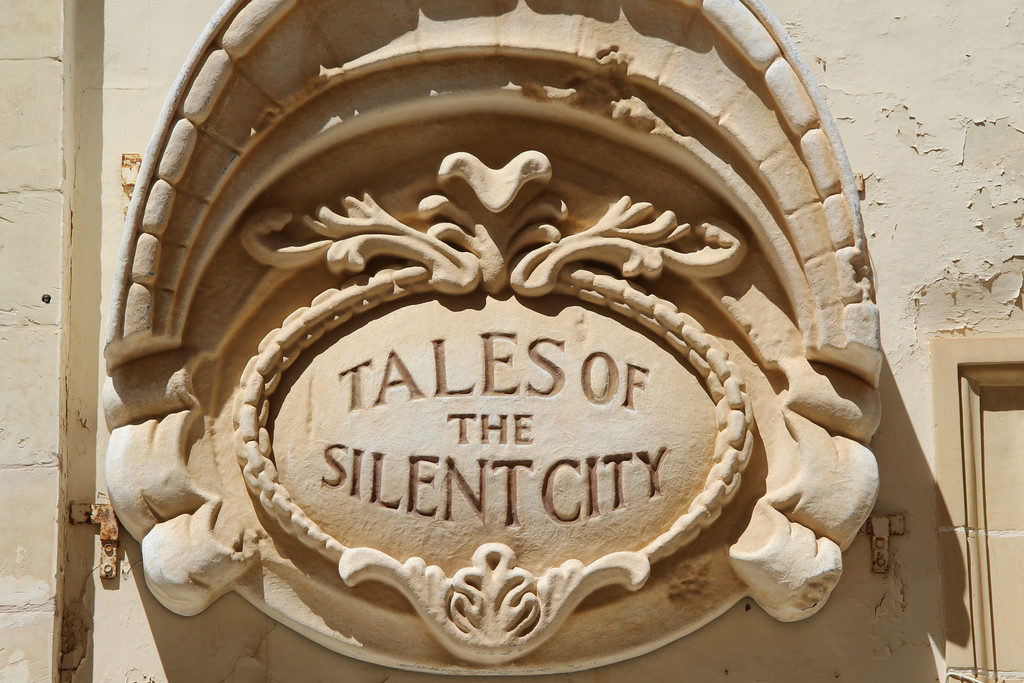
After visiting Mdina, we traveled by bus to Valletta which is the capital of Malta. We took a walking tour of the city. Immediately below is one of the streets. If you look on the right side near the flags, you will see a wooden balcony. A little farther down the street there are some more. Other balconies are made of stone and some of wrought iron, but the wooden ones are pretty unique to Malta. Wooden balconies with glass windows are called gallarija. The first one may have been at the Grand Master’s Palace in 1675 – and then of course, others wanted to have what the Grand Master had at his palace. (The Grand Master is a sovereign and religious head of the Order of Malta).
The second picture is of the Auberge de Castille. An auberge is an inn. The Auberge de Castille dates back to the 1570’s but it was rebuilt in 1740. Its original purpose was to house knights. The offices of the prime minister are now in this building.
The final two pictures in this section are of the exterior of St. John’s Co-Cathedral, dedicated to John the Baptist. It is called a co-cathedral because it serves as a bishop’s seat even though there is another serving this same purpose in Mdina. It was built between 1572 and 1577 under the direction of the Order of St. John. As way of background, the Order of St. John was founded in the 11th Century in Jerusalem to assist Christians who were traveling on a pilgrimage to the Holy Land. I have included a picture of the exterior of the cathedral and also one of the two bell towers. The balcony was used by the Grand Master when speaking to the people. The picture of the bell and clock tower I included has three clock faces – these show the time, day of the week, and day of the month. The interior of the church was originally very simple – much like the church’s exterior. But that was going to change!!



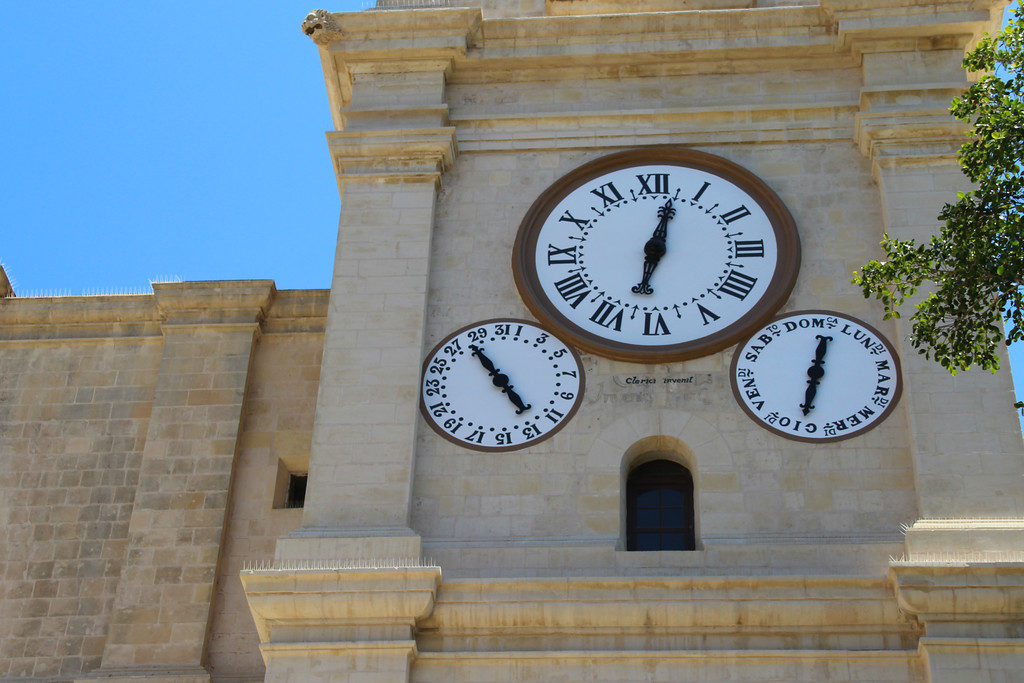
In the 1660’s, the Grand Master ordered that the interior of St. John’s Co-Cathedral be re-decorated so it was as beautiful (or more beautiful) than the churches in Rome. Today, most every square inch of the cathedral’s interior is covered with gold, silver or marble. In terms of beauty, I thought it rivaled St. Peter’s Basilica in Vatican City.
The first picture below is one I took from the back of the church. You can see the altar and also the beautiful ceiling. The entire floor of the cathedral is made of inlaid marble and are tombstones in memory of knights of the order (second and third pictures). The virtues of the honored knight are written on the tombstone in Latin. The last picture is of the balcony and ceiling in the back of the cathedral.

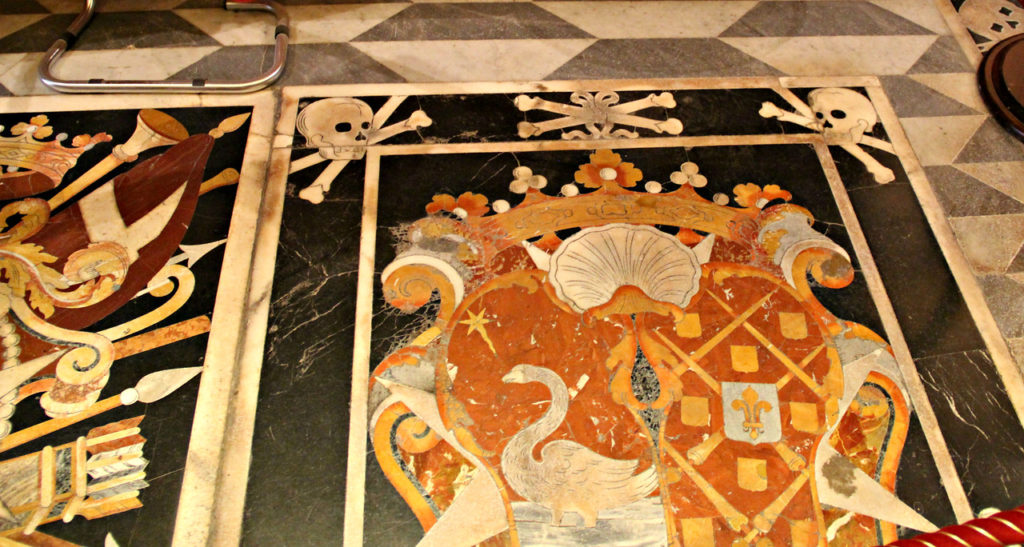
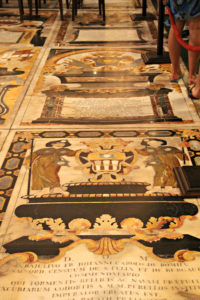
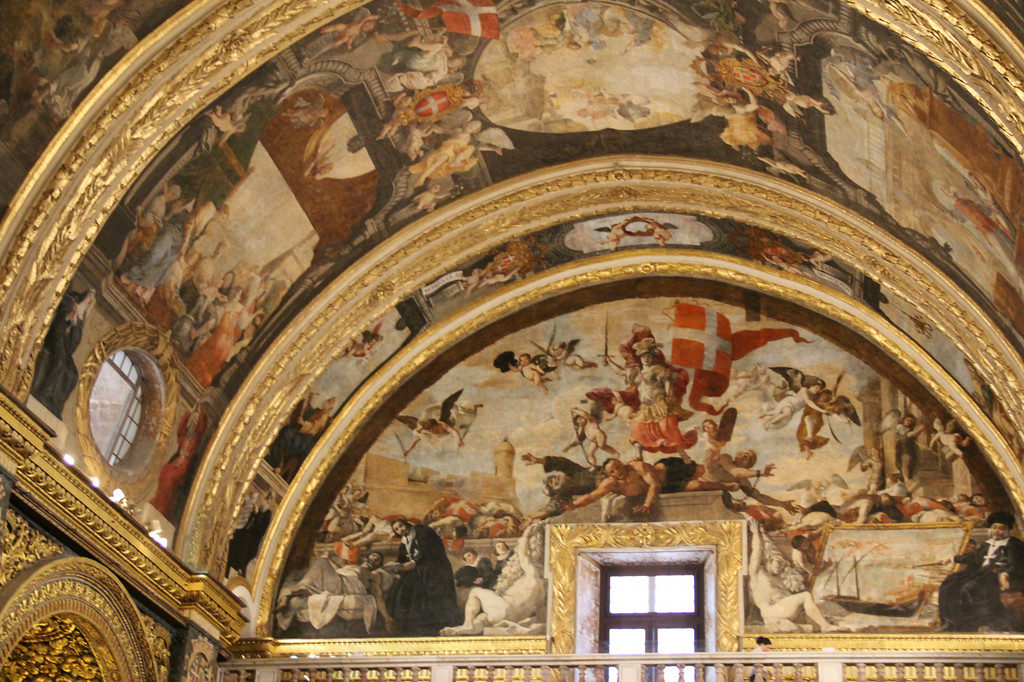
The next pictures are of the Chapel of the Langue of Italy. Different langues (language groups) were assigned a chapel by the grand master to redecorate. These chapels were on either side of the nave of the church. The different langues (there were eight of them) each tried to “out do” the other. The chapel pictured is dedicated to St. Catherine of Alexandria, chosen because she was the patron saint of Italian knights. The altar piece depicts “The Mystic Marriage of St. Catherine.” The Virgin Mary is holding the baby Jesus with St. Catherine to the right. It was painted around 1670 by Mattia Preti. He also painted several other altar pieces as well as the vault (ceiling) of the cathedral which are frescoes depicting the life of John the Baptist. Originally from Italy, he lived most of his life in Malta and was made a Member of the Order of St. John, being promoted to Knight of Grace. He is buried in St. John’s Co-Cathedral. The floor in the chapel (as in all the other chapels) is inlaid marble and are also tombstones for knights of the order just like in the main nave of the church. This chapel also has an ornate gold ceiling which is also pictured here.
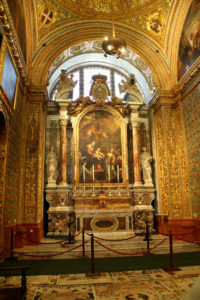
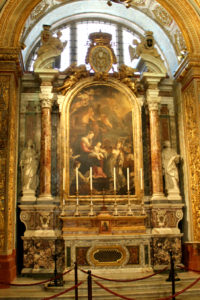

The next pictures were taken in the sanctuary. The first is a picture of the high altar with the gold encased organ pipes on either side. The altar is made of rare marbles and was a gift from the Grand Master in Carafa in 1685. Near the top right of the first picture you will see a silver lamp – it is suspended from the ceiling. It is another rare piece and was given by a knight in 1669. There is a sculpture of John the Baptist baptizing Jesus – it is more easily seen in the second picture. It was sculpted by Giuseppe Mazzuoli of Italy and made a part of the cathedral in 1703. In the third picture, you can see the canopy suspended over the altar. This is designed to bring attention to the altar and emphasize its importance. The fourth picture shows some of the organ pipes and the fifth is the intricate staircase that leads to the pulpit.
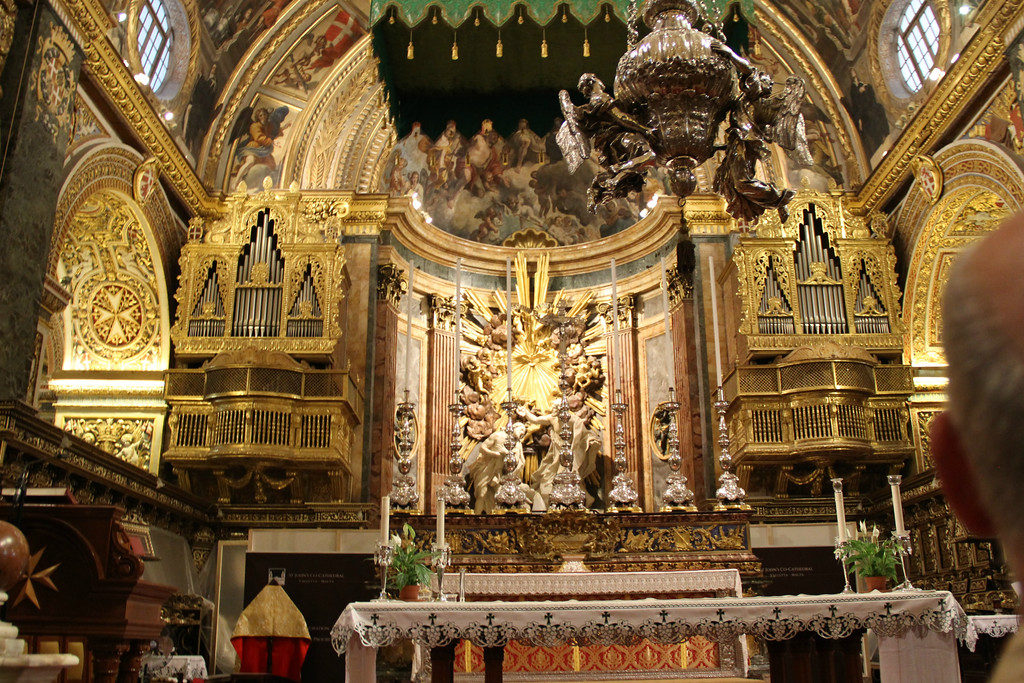

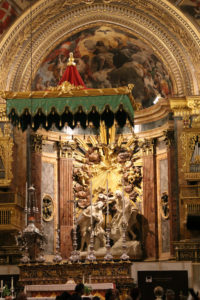


We also visited the Oratory. In the Catholic church, the oratory is not part of the parish church but is a place for prayer and the celebration of mass. The Oratory at St. John’s Co-Cathedral focuses on the the martyrdom of John the Baptist. The highlight is certainly the altar piece depicting “The Beheading of Saint John the Baptist.” Michelangelo Merisi da Caravaggio was commissioned to paint this piece in 1607. This painting is considered one of his best and the only one that he signed. The lighting made it hard to get a great picture, but you can see John the Baptist as he was beheaded, a girl waiting with a tray for his head, and other prisoners looking at the scene, perhaps anticipating that they would suffer the same fate.
There is a second painting by Caravaggio in the Oratory which was probably completed in 1607 or 1608. It is entitled “Saint Jerome Writing.” Saint Jerome, who lived from 347 to 420AD, is best known for translating the Bible into Latin. His translation became known as the Vulgate. In the painting, you will see St. Jerome likely involved in his translation of the Bible as well as a stone, a skull and a crucifix on the table. These are symbols of penance.
Michelangelo Merisi da Caravaggio has an interesting story. Caravaggio killed a man in Rome in 1606 and then went to Naples where he was protected by powerful people with connections to the Order of the Knights. While in Naples, he was awarded several commissions for paintings and gained recognition by many patrons. There was fear that he might be found by those wanting revenge for the murder so it was arranged for him to go to Valletta. The Grand Master was pleased to have a prominent artist who could enhance the beauty of St. John’s Co-Cathedral. Caravaggio died in 1610 at the young age of 38 while traveling from Naples to Rome, perhaps seeking the pope’s pardon. There is question as to the cause of his death – theories include illness, murder and lead poisoning. His paintings are known for the contrast between light and dark as well as his close observation of his subjects, both physically and emotionally.
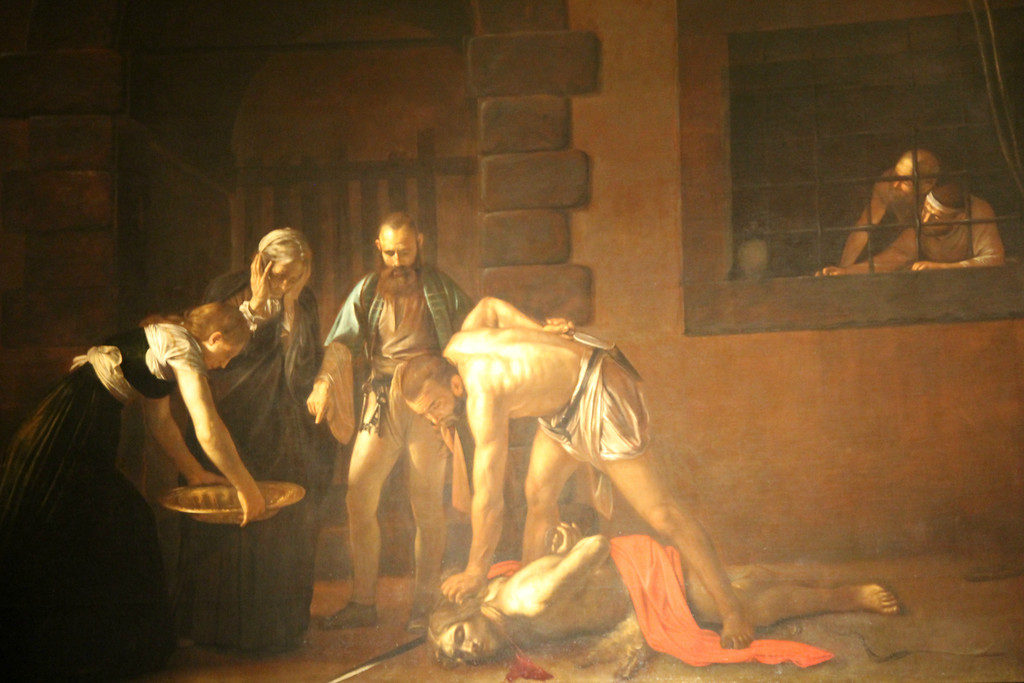
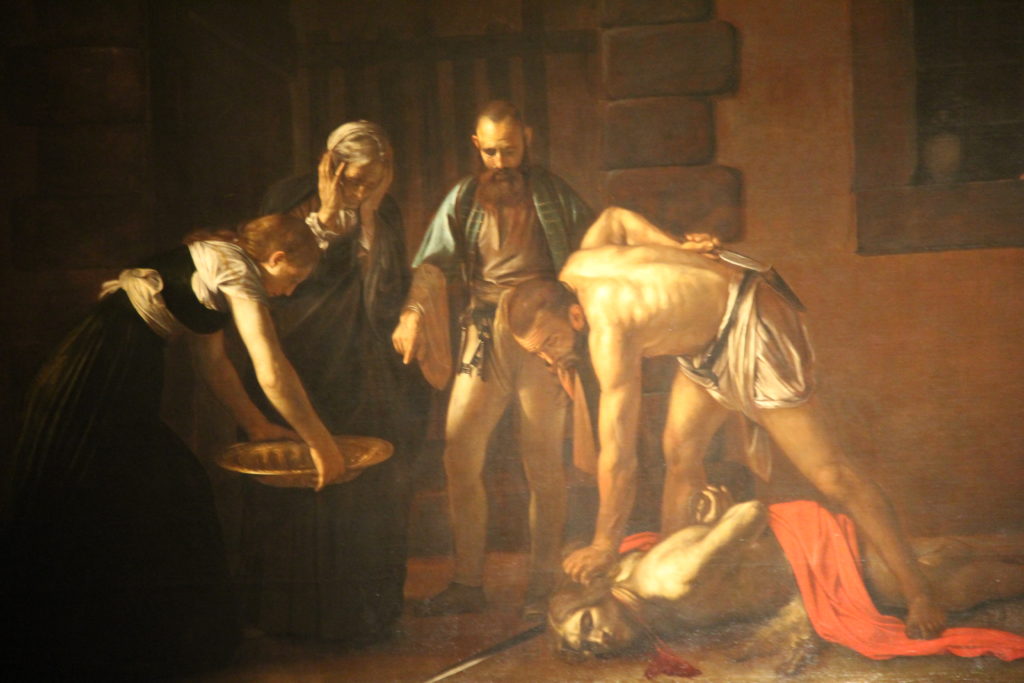
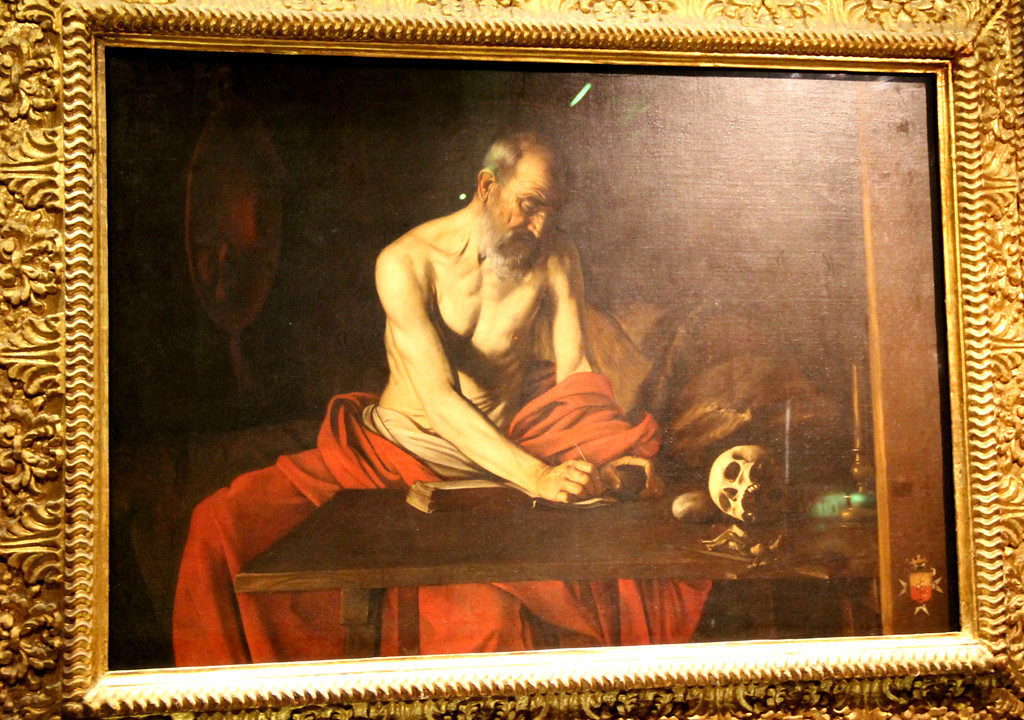
Across from our hotel was a park with fountains and several sculptures. The first is the Triton Fountain. It is made up of three bronze tritons (Greek gods) holding a basin. The base is made of concrete and was then covered with travertine. The fountain was sculpted between 1952 and 1959.
The next sculpture is part of a 2018 art project called “Kif Jgħid il-Malti” which is translated “So Says the Maltese.” This is one of thirteen such statues that have been placed around Valletta. They illustrate Maltese proverbs. The one pictured, a rather funny character looking at his watch, has the caption, “Time ripens the prickly pears” which means “People acquire experience and wisdom with the passage of time.”
The final picture in this section is the Malta Memorial, a memorial dedicated to the almost 2,300 seamen from a Commonwealth country who lost their lives in World War II and have no known grave. Malta was selected as the location for the statue because of the important role the Mediterranean played in the war. The bird is a gilded bronze eagle that is almost eight feet tall. It sits atop a 50 foot column.


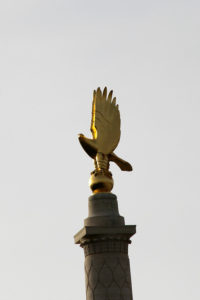
Our Tauck tour was quickly coming to an end. Where could we possibly go for our farewell dinner that would equal some of the incredible places we had already visited? Well, how about a palace! Our dinner was at the Palazzo Parisio and Gardens, originally built in 1733 as a hunting lodge for the Grand Master António Manoel de Vilhena. It is now owned by the Scicluna Family and the grandfather of the present owners was extravagant in its design. We had drinks and appetizers in the gardens and dinner in the ballroom, which had beautiful chandeliers, busts of the great masters, and walls of mirrors and gold. The sounds of a harp played during our dinner. It was a wonderful dinner, and like many others, ones we enjoyed with great people we met on our trip!

